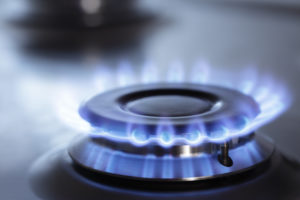 Natural gas swung between gains and losses after hitting a more than 5-year high as the extremely cold weather in the US boosted massive demand for the heating fuel, at a time when stockpiles are already at a 10-year seasonal low.
Natural gas swung between gains and losses after hitting a more than 5-year high as the extremely cold weather in the US boosted massive demand for the heating fuel, at a time when stockpiles are already at a 10-year seasonal low.
On the New York Mercantile Exchange (NYMEX), natural gas for delivery in March soared as much as 3.8% to $6.378 per million British thermal units, the strongest level since December 4th 2008, before easing down 1.98% to $6.027 per mBtu by 13:26 GMT. Day’s low was touched at $5.894 per mBtu. Yesterday, the energy source surged by 8.2%. The average daily trading volume of all futures traded was more than twice the 100-day average.
Prices have soared 45% so far in 2014, as the US experienced the coldest January in two decades, which boosted demand for the heating fuel and cut stockpiles at the first week of February to a 10-year low for that time of the year. The energy source settled last year 26% higher, the best performance since 2005 and second straight annual advance.
“Weather forecasts will cause price volatility through March but we expect end-March storage to come in at 1.1 trillion cubic feet, the lowest since 2004,” wrote in an e-mailed report Adam Longson, a New York-based analyst for Morgan Stanley, cited by Bloomberg. He also said that prices should decrease below $4 in the third quarter, as market overestimates costs to refill stockpiles.
CME Group Inc. announced earlier this month, that effective from February 6th, the initial margin for next-month natural gas futures, traded on NYMEX, will increase almost 10% to $ 5 500 for speculators from $5 005. This will be the highest margin requirement in more than 4 years, and will be almost double the initial margin at the beginning of this year, which was $2 530.
According to Standard & Poor’s GSCI gauge of 24 commodities, gas futures are the most volatile commodity this year as volatility more than doubled from 31.64% last year to 80.2% in 2014, and are also the second-biggest gainer after coffee.
US gas inventories levels
A government report may show tomorrow that US gas inventories fell by 257 billion cubic feet in the week ended February 14, according to the median estimate of 16 analysts in a Bloomberg News survey. This will come at a time when stockpiles are already at a 10-year seasonal low. In comparison, the five-year average drop for the same period is 133 billion cubic feet. The Energy Information Administration is scheduled release its weekly US gas inventories report at 15:30 GMT.
The Energy Information Administration reported last Thursday that US natural gas inventories fell by 237 billion cubic feet in the seven days through February 7th, above the median analyst forecast of 232 billion cubic feet. The decline also outstripped the five-year average drop of 162 bcf during the comparable week. EIA data showed that this was the largest February decline since 2007.
Total gas held in US underground storage hubs fell to 1.686 trillion cubic feet, the weakest level for this time of the year since 2004. US gas stockpiles were 33.9% below last year’s amount of 2.549 trillion cubic feet during the comparable week, which is also an all-time high. The deficit to the five-year average widened to a record 27.2%, up from 22.4% a week earlier.
According to data by the Energy Department’s statistical arm, supplies have fallen 50% in the past 12 weeks through January 31st.
Dangerously cold short-term weather outlook
NatGasWeather.com reported on February 20th that a brief warm-up continues to build into the central and eastern US ahead of a strengthening springlike storm, allowing temperatures to briefly get into the 40s across much of the northern US. The milder temperatures will temporarily ease natural gas and heating demand, according to the website.
The developing storm is expected to bring heavy showers and thunderstorms through the central and eastern US over the next several days, with light snow showers and colder temperatures developing behind it. The initial storm will impact most of the US today and even though it wont be very impressive, it will make way for colder ones to come. Tomorrow, the weather will be relatively calm, before on Sunday a very strong cold Canadian blast brings much colder-than-normal temperatures over the highest-consumption states of the northern US, with temperatures below zero and into the single digits.
The website warned that even more impressive and dangerously cold Arctic blast is expected to follow on Tuesday into Wednesday, with record breaking freezing temperatures, which will lead to very high natural gas and heating demand. Temperatures in the Great Lakes region may drop well below -20 to -30 degrees Fahrenheit, with only single digits moving deep into the Mid-Atlantic and parts of the Southeast.
Extended forecast
NatGasWeather.com’s extended forecast for the period ended March 5th called for an impressive Arctic blast to bring much colder-than-normal temperatures over the highest-consumption states of the northern US and over much of the central US at the beginning of next week. The Midwest and Northeast will experience brutally cold temperatures well below zero degrees Fahrenheit for at least the first 5 days of the outlook period.
Fresh Canadian type weather systems will track every few days through the Midwest and Northeast, with light snowfall and reinforcing doses of cold air. The cold blasts may push deep through the Mid-Atlantic and Southeast with single digits temperatures, boosting nations natural gas and heating demand. The website predicted very cold air over the northern US and milder conditions over the far south.





